Rick Just's Blog, page 153
August 19, 2020
The Leadore Charcoal Kilns
The charcoal kilns near Leadore resemble the skep or beehive depicted on the state flag of Utah. Made from local clay, they fit in well with the vast landscape of the Lemhi Valley. They are located about halfway between Salmon and Idaho Falls, some six miles west of State Highway 28.
Only four of the 16 original kilns survive today, now protected and interpreted by the US Forest Service and listed on the National Register of Historic Places.
The kilns are dwarfed by the towering mountains on both sides of the valley. They seem small at first, but as you approach them their scale becomes more apparent. They are 20 feet high—about the height of a two-story house—and 21-and-half feet in diameter. The circumference around the 14-inch-thick walls is about 73 feet.
Warren King of Butte, Montana, constructed the kilns in 1885 to service the needs of the Viola mine smelter across the valley in Nicholia. The kilns operated from 1885 to 1889. It was not a small operation. Some 200 men—mostly Irish, Italian, and Chinese immigrants—worked the nearby forests cutting, sawing, and transporting four-foot lengths of log, then carefully arranging them inside each kiln, stacked on end. The two-day burn reduced about 35 cords of wood to 500 pounds of charcoal.
Following a fire at the hoisting works, the Viola mine closed in 1889. The price of lead and silver kept it closed.
Locals discovered the utility of the perfectly good bricks and made most of the kilns into buildings and walls around the valley.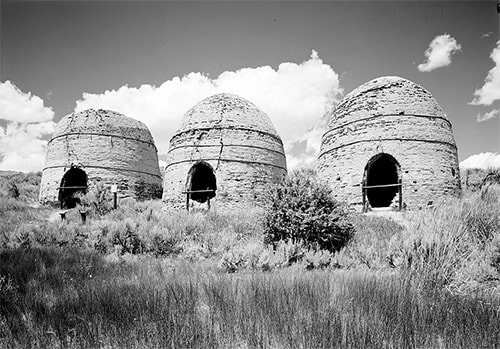 The Charcoal Kilns located off State Highway 28 near Leadore, Idaho. The kilns are listed on the National Register of Historic Places.
The Charcoal Kilns located off State Highway 28 near Leadore, Idaho. The kilns are listed on the National Register of Historic Places.
Only four of the 16 original kilns survive today, now protected and interpreted by the US Forest Service and listed on the National Register of Historic Places.
The kilns are dwarfed by the towering mountains on both sides of the valley. They seem small at first, but as you approach them their scale becomes more apparent. They are 20 feet high—about the height of a two-story house—and 21-and-half feet in diameter. The circumference around the 14-inch-thick walls is about 73 feet.
Warren King of Butte, Montana, constructed the kilns in 1885 to service the needs of the Viola mine smelter across the valley in Nicholia. The kilns operated from 1885 to 1889. It was not a small operation. Some 200 men—mostly Irish, Italian, and Chinese immigrants—worked the nearby forests cutting, sawing, and transporting four-foot lengths of log, then carefully arranging them inside each kiln, stacked on end. The two-day burn reduced about 35 cords of wood to 500 pounds of charcoal.
Following a fire at the hoisting works, the Viola mine closed in 1889. The price of lead and silver kept it closed.
Locals discovered the utility of the perfectly good bricks and made most of the kilns into buildings and walls around the valley.
 The Charcoal Kilns located off State Highway 28 near Leadore, Idaho. The kilns are listed on the National Register of Historic Places.
The Charcoal Kilns located off State Highway 28 near Leadore, Idaho. The kilns are listed on the National Register of Historic Places.
Published on August 19, 2020 04:00
August 18, 2020
Dr. Harlan Ustick
My GPS mapping system disagrees with most people in Boise when it comes to pronouncing the name Ustick. Boiseans typically pronounce it YOU-stick. The disembodied voice that comes out of my dashboard insists it’s UH-stick. So does the voice that comes out of my computer on HowToProunouce.com.
I’m sticking with the traditional Boise pronunciation because neither of the computer voices actually knew Harlan Page Ustick, and many Boiseans did, once.
It was Dr. Harlan P. Ustick, to be exact. Ustick, who was born in Ohio, was a prominent Boise physician who specialized in eye and ear maladies beginning in 1892. In the Treasure Valley he is most remembered for creating the town of Ustick as a development half a dozen miles outside of Boise. Ustick, the man, organized the Boise Valley Railway company with his partner Watson Donaldson. Ustick, the community, was founded in 1908 as the developers sold off five- and ten-acre lots of farmland “with terms so easy anyone can buy this.”
Harlan Ustick was also a partner in the Boise Gas and Light Company, which powered the railway. The tracks and cars would later become part of the system remembered today as the Interurban.
Ustick never did get big. Here we’re talking about the town, not making a judgment on the girth of its founder. It was about three blocks in size, boasting a bank, two churches, a school, a few retail stores, and an Interuban depot. It was known for its irrigated orchards in its heyday.
Dr. Ustick, a man of many interests, was also an orchardist, and secretary of the Southern Idaho Fruit Growers Association. He raised mostly plums (to dry for prunes), apples, and peaches. In 1902 he had 40 acres of apple orchards and 30 acres of plums, which brought in $7,500 when freighted to the east and to California.
There are traces of the little community along and near Ustick Road. The bank building is probably the most prominent. Dr. Ustick founded the bank upon the creation of the town in 1908. It closed in 1911. The building can still be seen today on the corner of Ustick Road and Mumbarto Avenue. The Ustick School is down Mumbarto a bit. Listed on the National Register of Historic Places it is today a residence.
The town’s founder had many investments, including in the Cinnabar Mine near Yellow Pine. He was there when he wrote his last letter to his wife, telling of the wonderful prospects of the mine, but complaining about the high altitude. He had been taking strychnine to stimulate his heart. Mrs. Ustick, according to an article in the September 28, 1917 edition of the Idaho Statesman, had written back to her husband pleading with him to return home. “If the altitude is affecting your health, come home at once; the richest mine in the state is not worth risking your health for.” He never got the letter. Dr. Harlan Page Ustick died on September 26, 1917 in Yellow Pine from heart disease.
The town that bore his name lasted about 50 years, with the post office closing down in 1958.
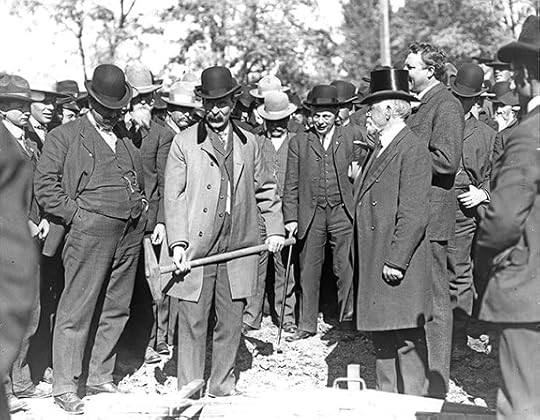 Doctor Harlan P. Ustick is the man in the top hat, at the “Silver Spike” ceremony for the Boise Valley Railway Company, which he operated. Photo courtesy of the Idaho State Historical Society, 64-57-8.
Doctor Harlan P. Ustick is the man in the top hat, at the “Silver Spike” ceremony for the Boise Valley Railway Company, which he operated. Photo courtesy of the Idaho State Historical Society, 64-57-8.
I’m sticking with the traditional Boise pronunciation because neither of the computer voices actually knew Harlan Page Ustick, and many Boiseans did, once.
It was Dr. Harlan P. Ustick, to be exact. Ustick, who was born in Ohio, was a prominent Boise physician who specialized in eye and ear maladies beginning in 1892. In the Treasure Valley he is most remembered for creating the town of Ustick as a development half a dozen miles outside of Boise. Ustick, the man, organized the Boise Valley Railway company with his partner Watson Donaldson. Ustick, the community, was founded in 1908 as the developers sold off five- and ten-acre lots of farmland “with terms so easy anyone can buy this.”
Harlan Ustick was also a partner in the Boise Gas and Light Company, which powered the railway. The tracks and cars would later become part of the system remembered today as the Interurban.
Ustick never did get big. Here we’re talking about the town, not making a judgment on the girth of its founder. It was about three blocks in size, boasting a bank, two churches, a school, a few retail stores, and an Interuban depot. It was known for its irrigated orchards in its heyday.
Dr. Ustick, a man of many interests, was also an orchardist, and secretary of the Southern Idaho Fruit Growers Association. He raised mostly plums (to dry for prunes), apples, and peaches. In 1902 he had 40 acres of apple orchards and 30 acres of plums, which brought in $7,500 when freighted to the east and to California.
There are traces of the little community along and near Ustick Road. The bank building is probably the most prominent. Dr. Ustick founded the bank upon the creation of the town in 1908. It closed in 1911. The building can still be seen today on the corner of Ustick Road and Mumbarto Avenue. The Ustick School is down Mumbarto a bit. Listed on the National Register of Historic Places it is today a residence.
The town’s founder had many investments, including in the Cinnabar Mine near Yellow Pine. He was there when he wrote his last letter to his wife, telling of the wonderful prospects of the mine, but complaining about the high altitude. He had been taking strychnine to stimulate his heart. Mrs. Ustick, according to an article in the September 28, 1917 edition of the Idaho Statesman, had written back to her husband pleading with him to return home. “If the altitude is affecting your health, come home at once; the richest mine in the state is not worth risking your health for.” He never got the letter. Dr. Harlan Page Ustick died on September 26, 1917 in Yellow Pine from heart disease.
The town that bore his name lasted about 50 years, with the post office closing down in 1958.
 Doctor Harlan P. Ustick is the man in the top hat, at the “Silver Spike” ceremony for the Boise Valley Railway Company, which he operated. Photo courtesy of the Idaho State Historical Society, 64-57-8.
Doctor Harlan P. Ustick is the man in the top hat, at the “Silver Spike” ceremony for the Boise Valley Railway Company, which he operated. Photo courtesy of the Idaho State Historical Society, 64-57-8.
Published on August 18, 2020 04:00
August 17, 2020
The Coin Kid
If you picture the dollar coin that features Sacajawea (or Sacagawea, if you prefer) you may remember the eagle on the obverse, and you might remember that Shoshone Tribal member Randy’L Teton served as the model for Sacajawea. But, did you remember that there are two people depicted on the coin?
Jean Baptiste Charbonneau was a part of the famous trip Lewis and Clark’s Corps of Discovery made to the Pacific. He would not remember the trip, because he was just a baby on his mother’s back, as depicted on the dollar coin. He played an important role just the same. Seeing a woman with a child as part of that strange group, which included a black man and a giant black dog, helped assure tribes they encountered that this was not a war party.
William Clark took a liking to the boy, giving him the nickname Pomp. More than that, after the death of Sacajawea, Clark took him in and paid for his education.
Jean Baptiste spoke English and French fluently. His father was Toussaint Charbonneau, a French trader who also went along on the expedition. He knew Shoshone well, thanks to his mother, and could converse in several Indian languages. During six years in Europe, he also picked up German and Spanish.
Charbonneau led expeditions in the West and guided for others. In 1846 he was the head guide for the Mormon Battalion’s trek from Kansas to San Diego. He was a trapper, gambler, magistrate, and freighter. He prospected for gold, and once owned a hotel in northern California. He even served as mayor of Mission San Luis Rey de Francia, near San Diego, for a time.
Pomp probably died as the result of an accident at a river crossing in Oregon when he was on his way, perhaps, to the mines in the Owyhees. His destination is uncertain as are the exact details of his death. An obituary for Jean Baptiste appeared in the Owyhee Avalanche in 1866, listing pneumonia as the cause of death.
There is a competing story about a Jean Baptiste Charbonneau who died on the Wind River Reservation in Wyoming, in 1885. Evidence that this was the Charbonneau that accompanied Lewis and Clark is slim.
The grave of John Baptiste Charbonneau, about 100 miles southwest of Ontario, Oregon is listed on the national register of historic places, and boasts no fewer than three historic markers.
Jean Baptiste Charbonneau was a part of the famous trip Lewis and Clark’s Corps of Discovery made to the Pacific. He would not remember the trip, because he was just a baby on his mother’s back, as depicted on the dollar coin. He played an important role just the same. Seeing a woman with a child as part of that strange group, which included a black man and a giant black dog, helped assure tribes they encountered that this was not a war party.
William Clark took a liking to the boy, giving him the nickname Pomp. More than that, after the death of Sacajawea, Clark took him in and paid for his education.
Jean Baptiste spoke English and French fluently. His father was Toussaint Charbonneau, a French trader who also went along on the expedition. He knew Shoshone well, thanks to his mother, and could converse in several Indian languages. During six years in Europe, he also picked up German and Spanish.
Charbonneau led expeditions in the West and guided for others. In 1846 he was the head guide for the Mormon Battalion’s trek from Kansas to San Diego. He was a trapper, gambler, magistrate, and freighter. He prospected for gold, and once owned a hotel in northern California. He even served as mayor of Mission San Luis Rey de Francia, near San Diego, for a time.
Pomp probably died as the result of an accident at a river crossing in Oregon when he was on his way, perhaps, to the mines in the Owyhees. His destination is uncertain as are the exact details of his death. An obituary for Jean Baptiste appeared in the Owyhee Avalanche in 1866, listing pneumonia as the cause of death.
There is a competing story about a Jean Baptiste Charbonneau who died on the Wind River Reservation in Wyoming, in 1885. Evidence that this was the Charbonneau that accompanied Lewis and Clark is slim.
The grave of John Baptiste Charbonneau, about 100 miles southwest of Ontario, Oregon is listed on the national register of historic places, and boasts no fewer than three historic markers.

Published on August 17, 2020 04:00
August 16, 2020
The Golden Dollar
One of the more beautiful coins ever produced by the U.S. Mint features the face of a living Idahoan. U.S. coins don’t honor living individuals, so you might have done a double take when you read that. The coin honors Sacagawea, the Shoshone woman who was such an important part of the Lewis and Clark Expedition.
If you spell her name “Sacajawea,” and pronounce it with a soft “J,” you’re not alone. Many Idahoans learned to spell and pronounce it that way growing up. Spelling it with a “G” and using the hard “G” sound to pronounce it seems a little more common nowadays.
The woman depicted on the coin is an artist’s rendition of Sacagawea. The artist, Glenna Maxey Goodacre, used Idahoan and Shoshone-Bannock Tribal Member Randy‘L Teton as a model for the coin. Goodacre is also known for designing the Vietnam Women’s Memorial in Washington, DC.
Randy’L He-dow Teton was chosen as the model for the coin by Goodacre when the artist visited the Institute of American Indian Arts in Santa Fe, where Teton’s mother was employed. Randy’L was going to school at the University of New Mexico at the time.
A graduate of Blackfoot High School, Randy’L Teton today is the public affairs manager of the Shoshone-Bannock Tribes.
Beautiful though the “golden dollar” is, it’s rare to see one in circulation today. You can get them easily enough, but people simply don’t carry coins the way they once did.

If you spell her name “Sacajawea,” and pronounce it with a soft “J,” you’re not alone. Many Idahoans learned to spell and pronounce it that way growing up. Spelling it with a “G” and using the hard “G” sound to pronounce it seems a little more common nowadays.
The woman depicted on the coin is an artist’s rendition of Sacagawea. The artist, Glenna Maxey Goodacre, used Idahoan and Shoshone-Bannock Tribal Member Randy‘L Teton as a model for the coin. Goodacre is also known for designing the Vietnam Women’s Memorial in Washington, DC.
Randy’L He-dow Teton was chosen as the model for the coin by Goodacre when the artist visited the Institute of American Indian Arts in Santa Fe, where Teton’s mother was employed. Randy’L was going to school at the University of New Mexico at the time.
A graduate of Blackfoot High School, Randy’L Teton today is the public affairs manager of the Shoshone-Bannock Tribes.
Beautiful though the “golden dollar” is, it’s rare to see one in circulation today. You can get them easily enough, but people simply don’t carry coins the way they once did.

Published on August 16, 2020 04:00
August 15, 2020
The Indispensible Jockey Box
When you hear the term “jockey box” what comes to mind? If you’ve been around Idaho for a while, you probably think of what most people in the US call a glove compartment. If you’re new to the state, you’re likely baffled by the term.
Knowing that it was a mystery to a lot of folks, I did a little research. The first instance of the term I found in an Idaho paper was in the October 18, 1881, edition of the Idaho World. It was mentioned during an interview with convicted murderer Henry McDonald. In describing the murder of George Meyer. McDonald said, “He and I then got into a quarrel about the dog, and he came at me, I pushed him, and he fell over a sagebrush; he got up and started for the jockey box to get a six-shooter…” The jockey box in that instance was probably a box beneath the seat of the man’s wagon or buckboard.
The next mention of the phrase is from the Idaho Daily Statesman, June 23, 1896. A couple of lines tell the story, “He opened the jockey box on his seat and rummaged around in it, finally producing a small hatchet and a big nail.
“‘I guess you’ll have to drive her out with this,’ said he, and he sat down on the ground and hung on to a buckeye bush with both hands, while one of his companions placed the end of the nail against the side of the tooth and hit it with the hatchet.”
Cowboy dentistry.
Note that those early mentions were about wagons, not cars. The term referred to a small (as jockeys are supposed to be) box in which one stored certain essentials, such as guns and dental tools. That small box inside automobiles that served the same purpose picked up the same name in Idaho and other Western states.
So, laugh all you want, but what do you store in YOUR glove box? Gloves? Maybe. More likely the owner’s manual, an old CD, your registration, a couple of pens that don’t work, 16 cents, and a four-year-old peppermint. So, why call it a glove compartment? Jockey box is a nice generic term to indicate that the box is equivalent to the junk drawer in your house. You know, a place to put your hatchet.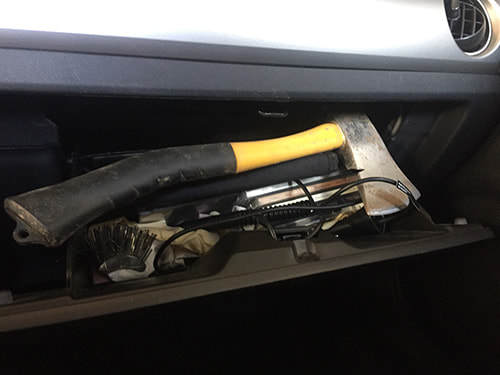
Knowing that it was a mystery to a lot of folks, I did a little research. The first instance of the term I found in an Idaho paper was in the October 18, 1881, edition of the Idaho World. It was mentioned during an interview with convicted murderer Henry McDonald. In describing the murder of George Meyer. McDonald said, “He and I then got into a quarrel about the dog, and he came at me, I pushed him, and he fell over a sagebrush; he got up and started for the jockey box to get a six-shooter…” The jockey box in that instance was probably a box beneath the seat of the man’s wagon or buckboard.
The next mention of the phrase is from the Idaho Daily Statesman, June 23, 1896. A couple of lines tell the story, “He opened the jockey box on his seat and rummaged around in it, finally producing a small hatchet and a big nail.
“‘I guess you’ll have to drive her out with this,’ said he, and he sat down on the ground and hung on to a buckeye bush with both hands, while one of his companions placed the end of the nail against the side of the tooth and hit it with the hatchet.”
Cowboy dentistry.
Note that those early mentions were about wagons, not cars. The term referred to a small (as jockeys are supposed to be) box in which one stored certain essentials, such as guns and dental tools. That small box inside automobiles that served the same purpose picked up the same name in Idaho and other Western states.
So, laugh all you want, but what do you store in YOUR glove box? Gloves? Maybe. More likely the owner’s manual, an old CD, your registration, a couple of pens that don’t work, 16 cents, and a four-year-old peppermint. So, why call it a glove compartment? Jockey box is a nice generic term to indicate that the box is equivalent to the junk drawer in your house. You know, a place to put your hatchet.

Published on August 15, 2020 04:00
August 14, 2020
Idaho's Ivy League
Looking for a good education? You might consider Purdue, Princeton, Harvard, Yale, or Cornell. They're all Ivy League universities, and they're all places in Idaho. All those sites are along the old Washington, Idaho, and Montana Railroad in north Idaho. You'll also find Wellesley, Vassar, and Stanford along the 47-mile-stretch of railroad.
The tradition of naming places along that route after colleges apparently started when railroad officials offered to name one site for a local man, Homer Canfield. He suggested they name the place Harvard, instead. An engineer named a siding Purdue, after his alma mater, and the die was cast. Students working summer jobs set about naming various sidings after their colleges.
Cambridge, Idaho, in Washington County, also owes its name to a railroad and Harvard University. Harvard was the alma mater of the president of the Pacific and Idaho Northern Railroad, and of course, Harvard is in Cambridge, Massachusetts.
And what about Oxford? Surely that's a good choice to receive your advanced degree? In England, that's true, but in Idaho, Oxford is a site a few miles north of Preston. It wasn't named after the university at all. Oxford was named because some oxen forded the creek there.
You can learn something at any of these Idaho sites, but none of them, as far as I know, offer advanced degrees.

The tradition of naming places along that route after colleges apparently started when railroad officials offered to name one site for a local man, Homer Canfield. He suggested they name the place Harvard, instead. An engineer named a siding Purdue, after his alma mater, and the die was cast. Students working summer jobs set about naming various sidings after their colleges.
Cambridge, Idaho, in Washington County, also owes its name to a railroad and Harvard University. Harvard was the alma mater of the president of the Pacific and Idaho Northern Railroad, and of course, Harvard is in Cambridge, Massachusetts.
And what about Oxford? Surely that's a good choice to receive your advanced degree? In England, that's true, but in Idaho, Oxford is a site a few miles north of Preston. It wasn't named after the university at all. Oxford was named because some oxen forded the creek there.
You can learn something at any of these Idaho sites, but none of them, as far as I know, offer advanced degrees.

Published on August 14, 2020 04:00
August 13, 2020
White Spring Ranch
John Lorang didn’t set out to create a museum when he built his home on the Palouse in 1884, 13 miles south of Moscow, near Genesee, Idaho. He was a farmer raising a large family with his wife; Mary, struggling some years and reaping exceptional harvests others.
The fertile soils of the Palouse helped him succeed in his endeavors at the place he called the White Spring Ranch. He began to retire from farming in 1910, transitioning to his other interests which included taxidermy, photography, coin collecting, and collecting natural specimens, particularly eggs and seashells. Sometime after 1914 his collections began taking up too much room in the family home, even though it had been significantly expanded over the years. He disassembled a nearby cabin and moved it onto his property to become his “curio cabin.” He built a second “curio house” close by and began filling the buildings with items of interest to him.
Not all of the items representing Lorang’s interest in the natural world could be kept indoors. He planted an extensive grove of trees on the property: oak, hickory, ash, sycamore, basswood or linden, elms, nut trees, haws, persimmon, and sassafras to name a few.
John passed away in 1926, but the White Spring Ranch has always remained in the family. What started as a curio collection has worked its way from the outbuildings meant to hold the artifacts, back into the house, which today is a museum packed with family and community memorabilia and items from John Lorang’s collection.
The White Spring Ranch is open to the public on Sunday and Tuesday afternoons, as well as by appointment. Each year the community looks forward to visiting the ranch for their annual ice cream social.
In July, 2020, the White Spring Ranch received the Sister Alfreda Elsensohn Award, the highest honor given to an Idaho Museum, by the Idaho State Historical Society and the Idaho Humanities Council.
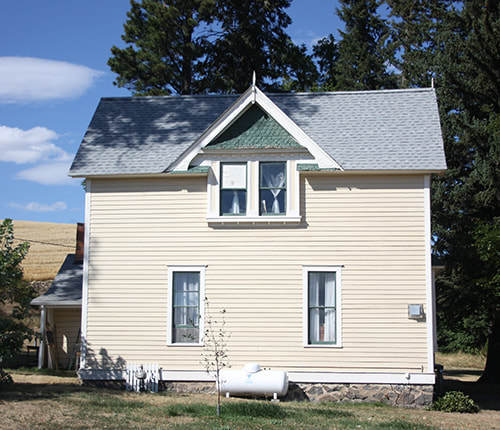 The original White Spring Ranch house was built in 1884. It more than doubled in size over the years with extensive additions.
The original White Spring Ranch house was built in 1884. It more than doubled in size over the years with extensive additions. 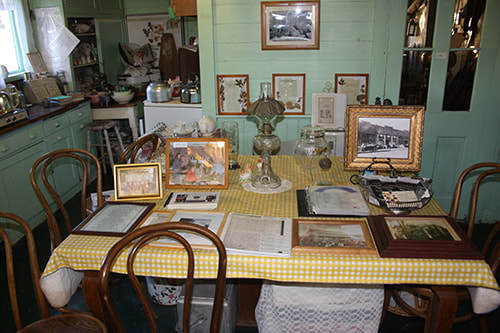 Every room of the original house is packed with artifacts.
Every room of the original house is packed with artifacts.
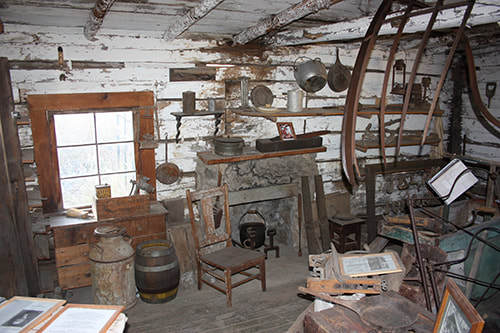 One of the “curio” buildings.
One of the “curio” buildings.
The fertile soils of the Palouse helped him succeed in his endeavors at the place he called the White Spring Ranch. He began to retire from farming in 1910, transitioning to his other interests which included taxidermy, photography, coin collecting, and collecting natural specimens, particularly eggs and seashells. Sometime after 1914 his collections began taking up too much room in the family home, even though it had been significantly expanded over the years. He disassembled a nearby cabin and moved it onto his property to become his “curio cabin.” He built a second “curio house” close by and began filling the buildings with items of interest to him.
Not all of the items representing Lorang’s interest in the natural world could be kept indoors. He planted an extensive grove of trees on the property: oak, hickory, ash, sycamore, basswood or linden, elms, nut trees, haws, persimmon, and sassafras to name a few.
John passed away in 1926, but the White Spring Ranch has always remained in the family. What started as a curio collection has worked its way from the outbuildings meant to hold the artifacts, back into the house, which today is a museum packed with family and community memorabilia and items from John Lorang’s collection.
The White Spring Ranch is open to the public on Sunday and Tuesday afternoons, as well as by appointment. Each year the community looks forward to visiting the ranch for their annual ice cream social.
In July, 2020, the White Spring Ranch received the Sister Alfreda Elsensohn Award, the highest honor given to an Idaho Museum, by the Idaho State Historical Society and the Idaho Humanities Council.
 The original White Spring Ranch house was built in 1884. It more than doubled in size over the years with extensive additions.
The original White Spring Ranch house was built in 1884. It more than doubled in size over the years with extensive additions.  Every room of the original house is packed with artifacts.
Every room of the original house is packed with artifacts. One of the “curio” buildings.
One of the “curio” buildings.
Published on August 13, 2020 04:00
August 12, 2020
Gretchen
Some of our more famous Idahoans weren’t born here. They chose Idaho, which simply indicates their good sense.
Gretchen Fraser was born in Tacoma, Washington. She fell in love with Idaho—and fell in love—in 1938 when she came to Sun Valley to compete in the Harriman Cup ski race. She met her future husband, Donald Fraser on the train traveling to Idaho. Donald had been a member of the 1936 US Olympic ski team. The two were married in 1939 and took up residence in Sun Valley. Both became members of the 1940 US Olympic ski team.
The 1940 games were canceled because of the war. It was 1948 before Gretchen got her chance to compete in the Olympics at age 29. She made the most of it, winning gold in the women’s slalom and silver in the combined event. She was the first American to win a gold medal in Olympic skiing.
Fraser continued to ski and promote the sport after her triumph. She made a couple of appearances in the movies as a stand-in skier for Sonja Henie in “Thin Ice” and that quintessential Sun Valley movie, “Sun Valley Serenade.” Fraser influenced future Olympians, mentoring Idaho medal winners Christin Cooper and Picabo Street, as well as Idahoan Muffy Davis, who won three gold medals in the Paralympics in 2012.
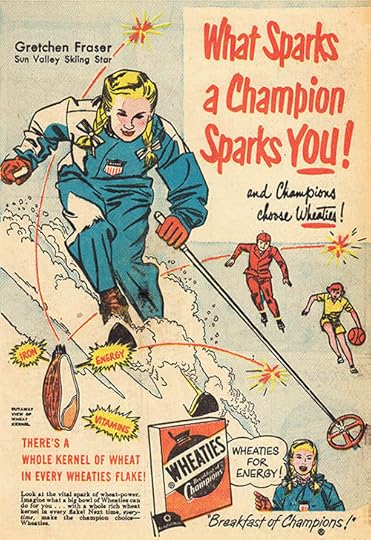
Gretchen Fraser was born in Tacoma, Washington. She fell in love with Idaho—and fell in love—in 1938 when she came to Sun Valley to compete in the Harriman Cup ski race. She met her future husband, Donald Fraser on the train traveling to Idaho. Donald had been a member of the 1936 US Olympic ski team. The two were married in 1939 and took up residence in Sun Valley. Both became members of the 1940 US Olympic ski team.
The 1940 games were canceled because of the war. It was 1948 before Gretchen got her chance to compete in the Olympics at age 29. She made the most of it, winning gold in the women’s slalom and silver in the combined event. She was the first American to win a gold medal in Olympic skiing.
Fraser continued to ski and promote the sport after her triumph. She made a couple of appearances in the movies as a stand-in skier for Sonja Henie in “Thin Ice” and that quintessential Sun Valley movie, “Sun Valley Serenade.” Fraser influenced future Olympians, mentoring Idaho medal winners Christin Cooper and Picabo Street, as well as Idahoan Muffy Davis, who won three gold medals in the Paralympics in 2012.

Published on August 12, 2020 04:00
August 11, 2020
Dispatch from the Past
Time for one of our occasional Dispatches from the Past where we feature oddities from newspapers that caught our eye while researching some unrelated topic.
From the August 8. 1867, Owyhee Bullion, an ad for the Poorman Saloon in Ruby City. “I have now opened a saloon in my own elegant styled building. I desire the patronage of those only WHO ARE LIABEL TO PAY.”
For context on this next one, you need to know that Idaho was a prohibition state beginning in 1916. Here’s a little blurb from the September 18, 1917 American Falls Press.
“Earl Fleming of the Bonanza Bar country was in town Friday night and somewhere in his travels picked up a bottle of the forbidden. He was in one of the pool halls and Deputy Sheriff Fred Walworth came in. Now you know Earl had known Fred a long time so he proffered the latter the bottle. Fred took the bottle all right, also the prisoner and Earl, after waiving his preliminary hearing, is awaiting under bond the session of the district court. Moral: don’t offer a sheriff a drink in a crowded pool hall.”
From the Blackfoot Idaho Republican, November 10, 1920.
“Because he had the Ford habit of getting out of his car when he wanted to start the engine, J.T. Burroughs, traveling salesman for an Idaho Falls wholesale grocery company, lost his Dodge car Saturday night, when it was struck at the crossing north of the depot by Short Line train No. 34, and barely escaped himself.”
The article went on to explain that the Dodge had stalled on the tracks, so Burroughs, out of habit, jumped out to crank the thing to a start. That’s when the train hit the car, which featured one of those new-fangled dashboard starters.
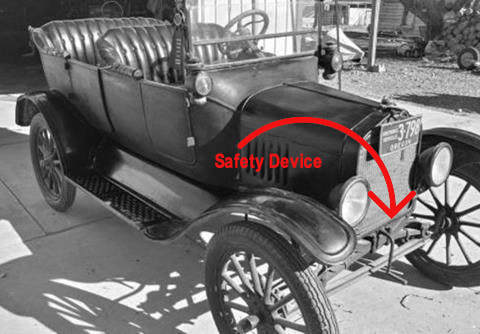
From the August 8. 1867, Owyhee Bullion, an ad for the Poorman Saloon in Ruby City. “I have now opened a saloon in my own elegant styled building. I desire the patronage of those only WHO ARE LIABEL TO PAY.”
For context on this next one, you need to know that Idaho was a prohibition state beginning in 1916. Here’s a little blurb from the September 18, 1917 American Falls Press.
“Earl Fleming of the Bonanza Bar country was in town Friday night and somewhere in his travels picked up a bottle of the forbidden. He was in one of the pool halls and Deputy Sheriff Fred Walworth came in. Now you know Earl had known Fred a long time so he proffered the latter the bottle. Fred took the bottle all right, also the prisoner and Earl, after waiving his preliminary hearing, is awaiting under bond the session of the district court. Moral: don’t offer a sheriff a drink in a crowded pool hall.”
From the Blackfoot Idaho Republican, November 10, 1920.
“Because he had the Ford habit of getting out of his car when he wanted to start the engine, J.T. Burroughs, traveling salesman for an Idaho Falls wholesale grocery company, lost his Dodge car Saturday night, when it was struck at the crossing north of the depot by Short Line train No. 34, and barely escaped himself.”
The article went on to explain that the Dodge had stalled on the tracks, so Burroughs, out of habit, jumped out to crank the thing to a start. That’s when the train hit the car, which featured one of those new-fangled dashboard starters.

Published on August 11, 2020 04:00
August 10, 2020
The Butch Bank
If Butch Cassidy had a sense of humor—and he apparently did—he would probably find it hilarious that one of the banks he robbed would one day become a museum celebrating that robbery.
Born Robert LeRoy Park in 1866 in Beaver, Utah, the man became “Butch,” a shortened version of “Butcher,” when he worked as one in Rock Springs Wyoming. The Cassidy he picked up from a friend and mentor who had that last name.
Cassidy and three “Wild Bunch” compatriots robbed the Montpelier bank on August 13, 1896, not long after he was released from prison in Wyoming where he served 18 months for stealing horses. They got away with somewhere between $5,000 and $15,000. His equally infamous sidekick, Harry Alonzo Longabaugh, better known as “The Sundance Kid,” would join the gang shortly after the Montpelier robbery.
The bank where the robbery took place was purchased and turned into a museum in 2016 by Radk Konarik. The Bank of Montpelier was the first bank chartered in the State of Idaho, opening its doors in 1891. As a museum it is now open during the summer, welcoming several thousand visitors each year who want to see the last standing bank that Butch Cassidy robbed.
Cassidy and Sundance were both killed in a shootout with the Bolivian Army in 1908, as depicted in the 1969 movie Butch Cassidy and the Sundance Kid. Unless they weren’t. There are many stories that say they came back to the States after their South American adventure and lived quiet lives. You can start chasing those down for fun on the Butch Cassidy Wikipedia page.
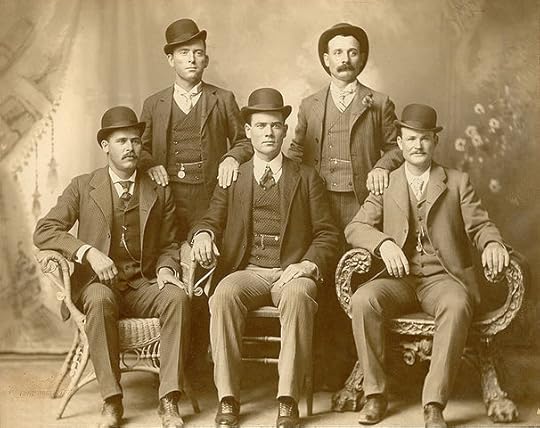 The famous formal photo of the “Wild Bunch.” In the back from left are William “News” Carver and Harvey Logan. In front from left are Harry Alonzo Longabaugh (The Sundance Kid), Bill Kilpatrick, and Robert LeRoy Parker (Butch Cassidy).
The famous formal photo of the “Wild Bunch.” In the back from left are William “News” Carver and Harvey Logan. In front from left are Harry Alonzo Longabaugh (The Sundance Kid), Bill Kilpatrick, and Robert LeRoy Parker (Butch Cassidy). 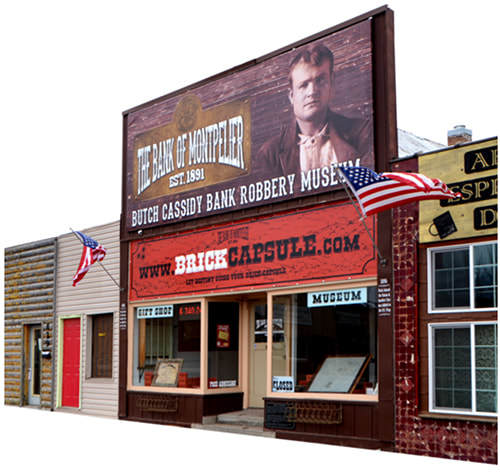 The bank museum as it appears today.
The bank museum as it appears today.
Born Robert LeRoy Park in 1866 in Beaver, Utah, the man became “Butch,” a shortened version of “Butcher,” when he worked as one in Rock Springs Wyoming. The Cassidy he picked up from a friend and mentor who had that last name.
Cassidy and three “Wild Bunch” compatriots robbed the Montpelier bank on August 13, 1896, not long after he was released from prison in Wyoming where he served 18 months for stealing horses. They got away with somewhere between $5,000 and $15,000. His equally infamous sidekick, Harry Alonzo Longabaugh, better known as “The Sundance Kid,” would join the gang shortly after the Montpelier robbery.
The bank where the robbery took place was purchased and turned into a museum in 2016 by Radk Konarik. The Bank of Montpelier was the first bank chartered in the State of Idaho, opening its doors in 1891. As a museum it is now open during the summer, welcoming several thousand visitors each year who want to see the last standing bank that Butch Cassidy robbed.
Cassidy and Sundance were both killed in a shootout with the Bolivian Army in 1908, as depicted in the 1969 movie Butch Cassidy and the Sundance Kid. Unless they weren’t. There are many stories that say they came back to the States after their South American adventure and lived quiet lives. You can start chasing those down for fun on the Butch Cassidy Wikipedia page.
 The famous formal photo of the “Wild Bunch.” In the back from left are William “News” Carver and Harvey Logan. In front from left are Harry Alonzo Longabaugh (The Sundance Kid), Bill Kilpatrick, and Robert LeRoy Parker (Butch Cassidy).
The famous formal photo of the “Wild Bunch.” In the back from left are William “News” Carver and Harvey Logan. In front from left are Harry Alonzo Longabaugh (The Sundance Kid), Bill Kilpatrick, and Robert LeRoy Parker (Butch Cassidy).  The bank museum as it appears today.
The bank museum as it appears today.
Published on August 10, 2020 04:00



